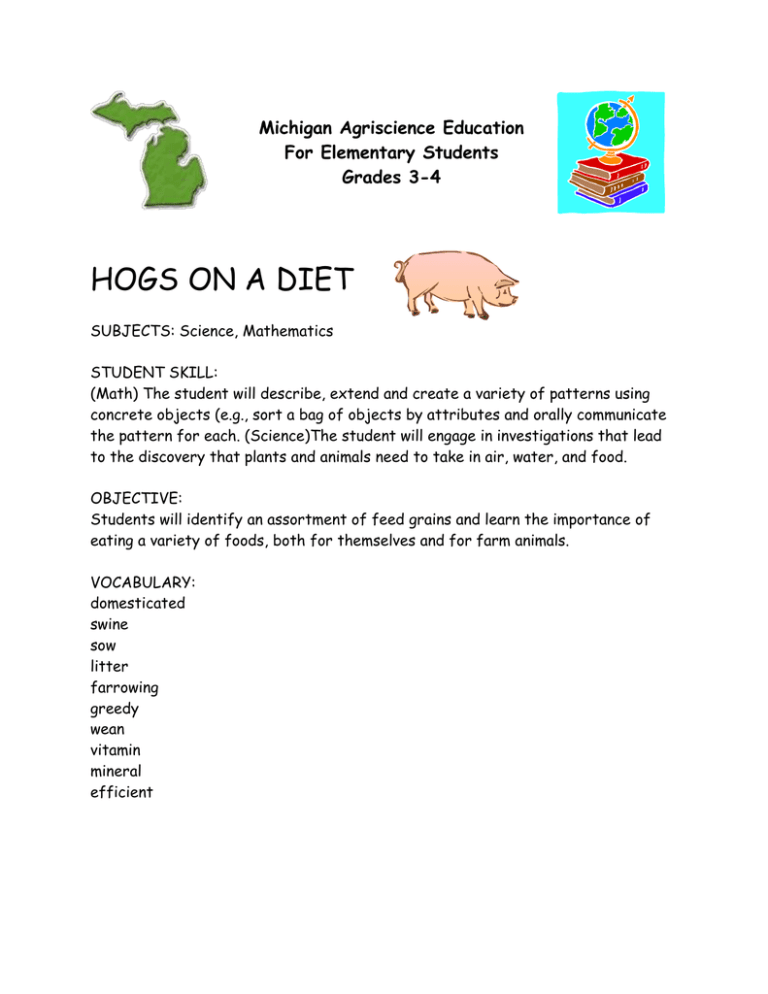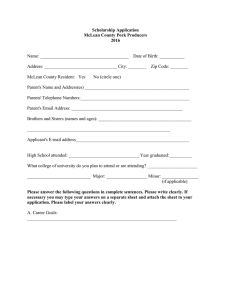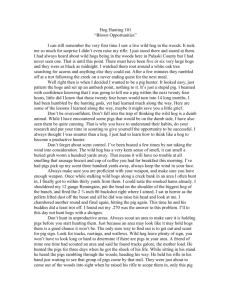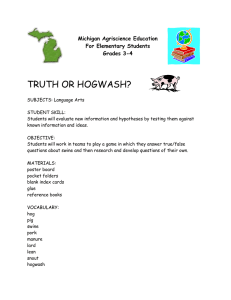HOGS ON A DIET Michigan Agriscience Education For Elementary Students
advertisement

Michigan Agriscience Education For Elementary Students Grades 3-4 HOGS ON A DIET SUBJECTS: Science, Mathematics STUDENT SKILL: (Math) The student will describe, extend and create a variety of patterns using concrete objects (e.g., sort a bag of objects by attributes and orally communicate the pattern for each. (Science)The student will engage in investigations that lead to the discovery that plants and animals need to take in air, water, and food. OBJECTIVE: Students will identify an assortment of feed grains and learn the importance of eating a variety of foods, both for themselves and for farm animals. VOCABULARY: domesticated swine sow litter farrowing greedy wean vitamin mineral efficient MATERIALS: - Shoebox - An assortment of animal feed grains available from feed stores (Ask for samples from broken bags.)— wheat, corn, soybeans, grain sorghum BACKGROUND: Swine were among the first of all animals to be domesticated —around 6,000 years ago. A domesticated animal is one that is trained to live in a human environment and be of use to humans. The Spanish explorer Hernando DeSoto brought the first swine to the New World in 1539. Female swine are called sows. Sows give birth to litters of pigs twice a year. Each litter usually has eight to 12 baby pigs. Giving birth to baby pigs is called farrowing. Baby pigs appear very greedy when they are competing for food from their mothers. For this reason the words “pig” and “hog” have come to be associated with greedy behavior. Despite their reputation, pigs will never overeat. Once a pig is full, it stops eating. Pigs are weaned when they are two to four weeks old. They are called “nursery pigs” until they reach 50 pounds and “growing/finishing pigs” from then until they reach about 240 pounds. After that they are called hogs. Hogs are usually taken to market when they weigh 240-280 pounds. In the past hogs were fed table scraps and had a reputation for eating just about anything. The meat from hogs fed that way was very high in fat. Today’s swine producers are more careful about what they feed their animals. Some of the food fed to swine are corn, wheat and soybean meal. Vitamins and minerals are added to increase growth and improve health.Today’s hogs weigh more, but because producers plan their diets carefully, they grow more efficiently and yield more lean meat than ever before. Bacon, pork sausage, pork chops and ham all come from hogs. In addition, swine are used in the production of non-food products like fertilizer, glass, china, floor wax, chalk, crayons, and heart valves. Pork provides protein, B-vitamins and thiamin to our diets. Pork has three times as much thiamin as any other food. Thiamin changes carbohydrates into energy and promotes a healthy appetite. PRE-LAB: Have students list what they had for dinner last night. What do they think pigs have for dinner? ACTIVITY: 1. Before class time, place a few grains of each type of feed in the shoebox. Place the shoebox on a table in the front of the room so students can see it, but don’t let them move it or look inside. 2. Ask students what it means to “hog” something. Where did that saying come from? How do hogs eat? What do they eat? 3. Share background information. 4. Invite your students to guess what is in the box. Shake the box. Is there any sound? What does it sound like? Open the box, and allow the children to feel what is inside without seeing it. What does it feel like? 5. Show students the feed grains, and ask them to identify each one. Explain that hogs and other kinds of animals eat these kinds of grains and that, just like us, hogs need a variety of foods to help meet their nutritional needs. 6. Have students sort the grains and place them in piles, then graph the quantities. ADDITIONAL ACTIVITIES: 1. Discuss the nutritional value of pork, and ask students where pork belongs on the USDA Food Guide Pyramid. 2. Have students make paper pig snouts to wear. Take a small paper cup and trim the rim to the size of a pig snout. Draw nostrils on the bottom. Punch two holes on either side of the cup about 1/4 inch down from the top. Thread string or ribbon through the holes and tie around the student’s head. 3. Have students make a list of common phrases associated with swine (living high on the hog, acting like a pig in a poke, being in hog heaven) and research their meaning and origins. EXTRA READING: Geisert, Arthur, Oink, Houghton Mifflin, 1995. King-Smith, and Anita Jerame, All Pigs Are Beautiful, Candlewick, 1995. “Pork 4 Kids,” National Pork Producers Council, www.pork4kids.com Scieszka, Jon, and Lane Smith, The True Story of the 3 Little Pigs, Viking, 1999. Tym, Kate, and John Blackman, Pig Tales, Element, 1999. EVALUATION Were students able to describe the sound and feel of the feed grain? Did they understand why the words “hog” and “pig” are associated with greedy behavior? * Original can be found at Oklahoma Ag in the Classroom, www.clover.okstate.edu



